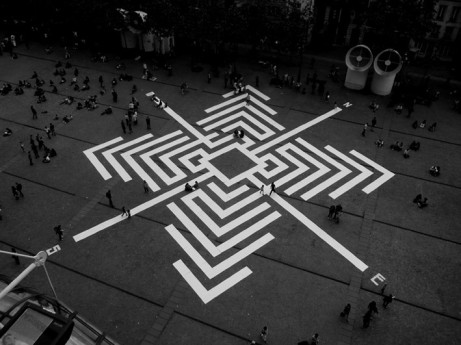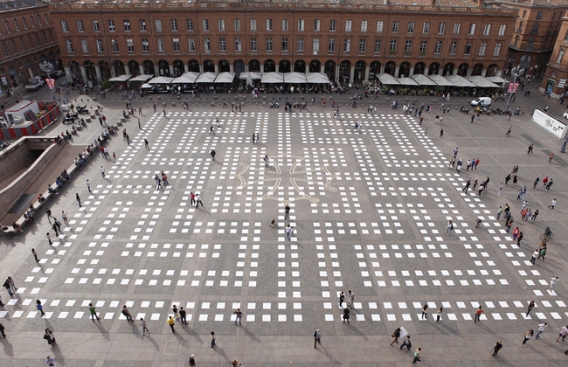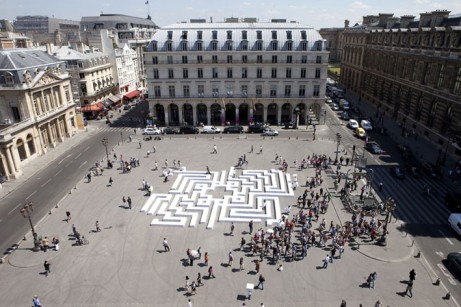By Jill Thayer, Ph.D., Contributing Writer, ARTDISTRICTS Magazine, Florida, December, 2015 [See: http://artdistricts.com/codification-and-form-semiotics-revisited-the-works-of-l’atlas/]
Writing is the first abstraction of reality. Man has created a symbolic geometric abstraction that extends from the phoneme to the ideogram in order to convey its mental representation of the world. – L’Atlas
In today’s media-driven culture, hypermedia, digital convergence, and ubiquitous information are in the fore of mass communication that connects our global society. In social media, Twitter allows the user to “tweet” or microblog alphanumeric text messages up to 140 characters to communicate, condense, and disseminate content messaging to a mainstream of “followers.” Facebook boasts that 1.39 billion people log onto the platform each month, more than the population of China.
Anthropologist Clifford Geertz states that culture is “an historically transmitted pattern of meanings embodied in symbols, a system of inherited conceptions expressed in symbolic forms by means of which men communicate, perpetuate, and develop their knowledge about and their attitudes toward life” (Geertz 1973d:89).
Taking these principles to task, French artist Jules Dedet Granel, aka. L’Atlas deconstructs meaning and message into pure semiological iconography, which evolved from his early work in Graffiti and Hip Hop. L’Atlas’ rise to prominence in the 1990s Street Art movement showcased his keen talent and urban scrawl on tags, posters, transit, manholes, and architectural spaces. His large-scale public installations of minimalist forms and complex labyrinths resemble patterns of circuit boards, Pac-Man video games, and QR codes. The site-specific installations of geomorphic cryptograms challenge the viewer to decipher the code in the syncretistic contexts of public art.
L’Atlas explored the art of calligraphy through books, and classes at the Comptoir des Écritures, rue Quincampoix. He studied with masters of ancient and modern calligraphy in countries such as Morocco, Cairo, Syria, and China; and learned sigillography, the art of engraving seals in marble. L’Atlas merges the methodologies of these ancestral traditions in the contemporary canon of Western culture, as he renews his formal expression of the letter from a codified rhythm of writing. His painting, sculpture, and installations are influenced by a typographic process of transposing Arabic Kufi codes into the Latin alphabet with letterforms and Chinese ideograms. The characters and geometric shapes fuel the artist’s expression and intent.
“I want to mix something very old with an emerging culture, feed contemporary art with classic art––and of course, I use public places as exhibition space.”
L’Atlas creates a semiological language in the confluences of Op Art and Geometric Abstraction. It brings to mind the grid patterns of Mondrian, archetypal symbols of Sol Lewitt, the visual perceptions of M.C. Escher and Vasarely, and the perceptual juxtopositions of Bridget Riley. L’Atlas, much like Riley, engages the viewer in the process of observation, but also, in the interaction of it.
In 2000, L’Atlas began using the compass as a theme in his public installations during the urban renovation of Paris that destroyed many graffiti landmarks around the city. The compasses were created with white gaffer tape on the street asphalt to signify geographic roadmap and the familiar that once existed. He also began creating a large body of work in the studio, which he exhibits in art centers, museums, and galleries internationally.
In a recent exhibition at Lebenson Gallery, Paris, L’Atlas created smaller scale canvases to fit the intimacy of the space. His work, a mixed-technique using aérosol on laque, combines multi-colored stripes of crossed horizontal and vertical lines in a dynamic array of dayglo and metallic paints.
The checkered-like installation features a standard light view and a blacklight switch to showcase the fluorescent pigments employed in each piece. The result is quite stunning, as luminous imagery becomes windows of the world in a neon-infused skyline. A sophisticated illusion incarnate from the psychedelic scene of the late ‘60s. L’Artist describes the visage as “a bridge between Graffiti and Optic Art.”
The artist’s solo exhibition at Leila Mordoch Gallery, Miami features a selection of pieces from his European show. The palette is simple. Vertical stripes and patterns emerge in opaque colors of orange, red, apple green, or fuchsia in stark contrast with opposing stripes in black, silver, white, or grey. The optical illusions are mesmerizing in vibrating hues that channel Albers’ language of color. The progression is seamless as L’Atlas shifts his approach from the simple complexities of large-scale works to the intricate illusions of a two-dimensional plane.
In the expanded field of public art, there is a dimensionality to L’Atlas’ work. Set in the properties of vector-based forms, observers are drawn into a maze of wonder.
____
Jules Dedet Granel is represented by Galerie Magda Danysz (Paris), Catherine Ahnell Gallery (New York), Lelia Mordoch Gallery (Miami) and David Bloch Gallery (Marrakech). His work was exhibited at Centre Pompidou, Fondation Cartier, Grand Palais in Paris, French Institutes, and Biennials and Art Fair including Moscow, New York, and Beijing. He also produces monumental performances in public and private institutions, as Printemps de Septembre, Toulouse, France. His work is included in corporate and private collections including Agnès b. among others. For more on the work of L’Atlas, visit: latlas.org
Jill Thayer, Ph.D. is an artist, educator, and curatorial archivist. She is faculty at Santa Monica College in Art History: Global Visual Culture, and Post University, Malcolm Baldrige School of Business MBA program in Integrative Strategies. Her oral history narratives, “In Their Own Words: Oral Histories of CGU Art,” featuring Claremont Graduate University professors emeritus and contemporary artists are included in Archives of American Art at The Smithsonian Institution.




You must be logged in to post a comment.